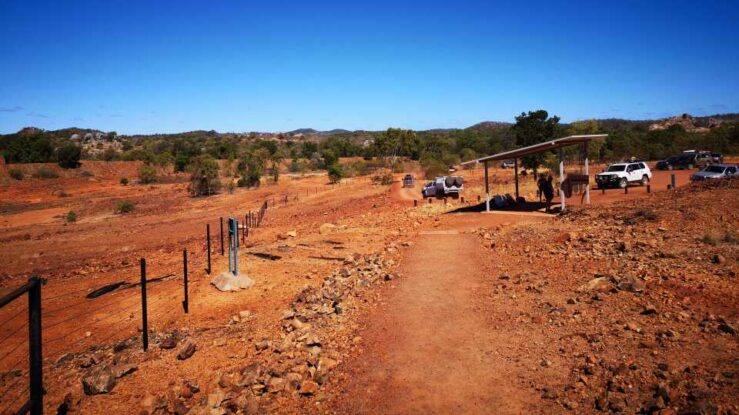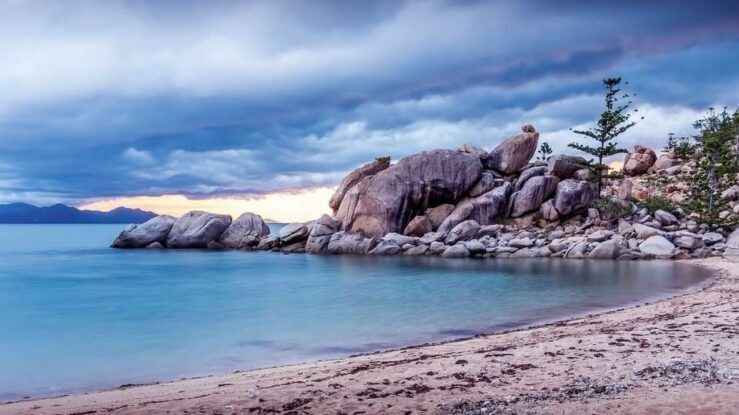Exploring The Great Ocean Road Australia – G’day Mate!
1. History
2. Memorial Arch
3. Otway Ranges
4. Twelve Apostles
5. Loch Ard Gorge
We are on a day tour to the Great Ocean Road southwest of Melbourne in Australia. Our group is not big – 15 people – plus Simon, our tour guide, a stout Australian with beautifully tattooed arms – and a former truck driver! He says that from the beginning, so we will have confidence in his driving on the winding coastal road later today. He has notably driven tens of thousands of kilometres across Australia – and he knows his vehicle inside out!
Simon soon shows his excellent skills – not only as a driver – but also as a competent tour guide! As we leave Melbourne, he begins to reveal his family background and profound knowledge of Australian history. He is an entertaining storyteller and catches our attention with ease, totally spellbinding the group.
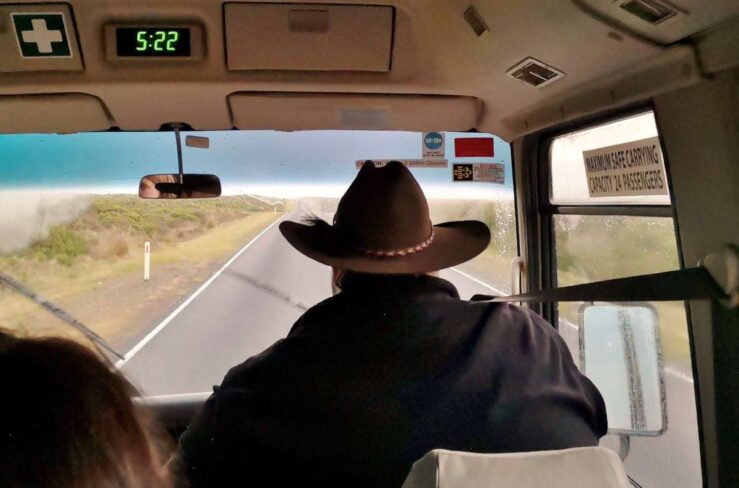
Our driver provides us with a number of Great Ocean Road facts | Photo: Travel In Culture
On our way towards the Australian south coast, Simon introduces us to the Great Ocean Road history, adding a touch of his family history.
The construction of the Great Ocean Road in Australia began as a project for the returned WWI servicemen, funded by public donations to the Great Ocean Road Trust from 1917. The Great Ocean Road, spanning over 250 kilometres (155 miles), became the longest memorial in the world, a memorial to the Australian soldiers and diggers who sacrificed their lives for Australia! The work they undertook to build the road on the steep cliffs was both extremely challenging and highly dangerous – and some of the workers inevitably lost their lives.
Our tour guide explains that from 1922 to 1936, travellers had to pay a toll to use the road!
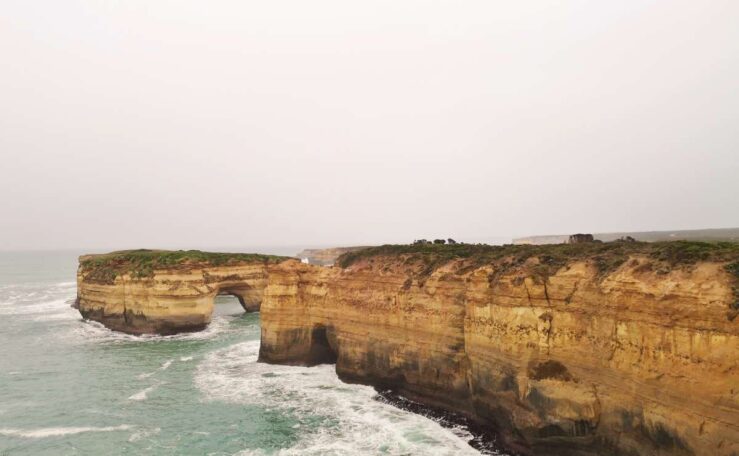
Loch Ard. The Great Ocean Road offers magnificent views of the seascape | Photo: Travel In Culture
Eventually, all the isolated coastal villages and settlements in this part of Southern Australia were linked together by a new, fabulous road named the Great Ocean Road! The final result was a much more vibrant life in and around the coastline villages and towns.
We are driving through the port city of Geelong and the pretty coastal town of Anglesea.
Already on the bus, Simon tells us what to do if we spot a kangaroo in order for everyone to get a chance to see it. A loud shout: ‘Kangaroo’ will do! And that is heard several times during our ride towards the Great Ocean Road. Agile kangaroos hop around in between the trees and bushes.
Before arriving at the ocean, we have a brief morning stop at a tranquil location overlooking a green field – which surprises us with a mob of hopping kangaroos well within sight.
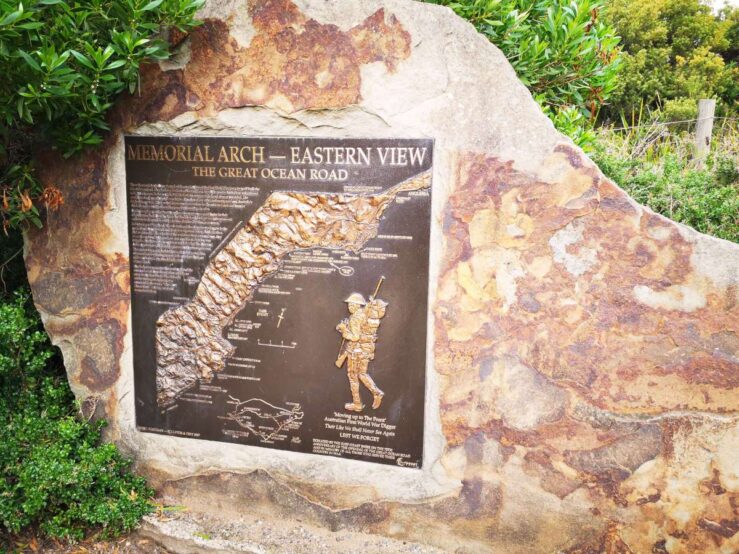
Photo: Travel In Culture
The next stop is the Great Ocean Road Memorial Arch, Eastern View, a bit outside the seaside town of Lorne. 1.2 million vehicles pass under this archway each year to admire the picturesque ocean drive!
That is the third arch on this site commemorating the Victorians who served in the First World War (1914-18). The first tribute to the soldiers, the arch from 1939, was replaced in 1973 when widening the road. A third one was erected in 1983 after a fire, the Ash Wednesday Bushfires, had devastated the second arch. Still, the original sign sits on top of the current arch!
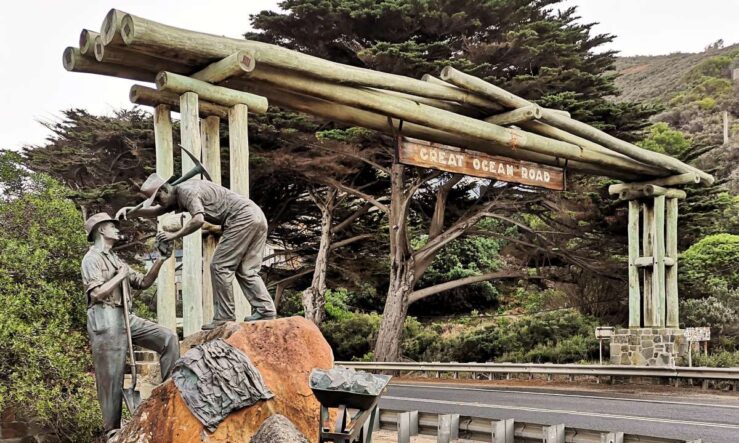
Photo: Travel In Culture
Again, Simon weaves his family story into the historical facts about the Great Ocean Road. He is out of a soldier family with a link back to the road diggers. Therefore, our driver has immense respect for all the brave men who contributed to building the famed coastal road. Proud of his roots and his family’s acts, Simon shows a photo of his son in the army uniform – he will continue the soldier tradition in the family.
As our bus twists and turns around one of the cliffs, we can only agree that the scenery is spectacular. With great enthusiasm, our eager driver even guides us to spot a small herd of fur seals on the slippery rocks on the shore.
Simon is very dedicated to teaching us about Australian culture. He puts on Australian music while we are on the roads and vigorously shouts out the rhetorical question once in a while: ‘Where are we?’ – teaching us the correct pronunciation of Australia: ‘Straya’.
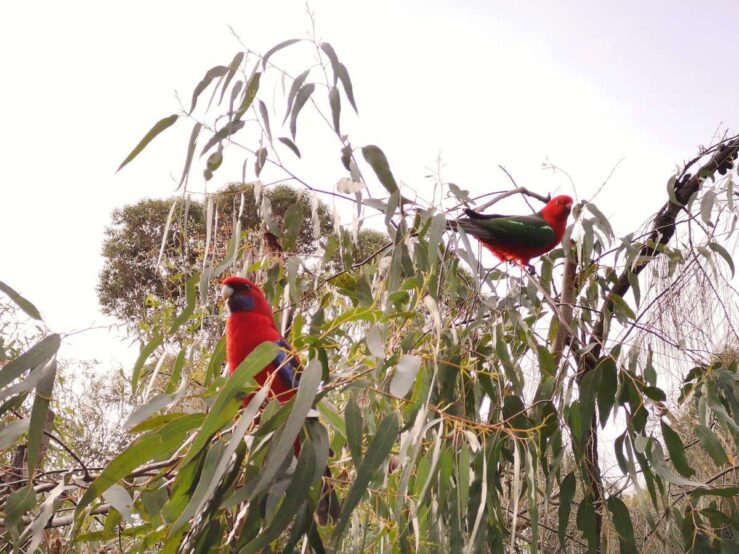
Photo: Travel In Culture
It is the perfect trip to see some wildlife. After lunch in the quaint town of Apollo Bay, Simon takes us to a hidden gem crowded with colourful birds and koalas in the tree tops. The koala bears sit calmly on the branches, chewing eucalyptus leaves – paying no attention to their spectators! He explains that this is a dream of a koala habitat with all the eucalyptus trees around – their preferred food source. Moving through this fantastic koala habitat in the wild, we also come close to the parrots and cockatoos. We learn how to distinguish the male and female parrots by their colour nuances!
4-day itinerary for Sydney
15 things to do in Melbourne
Road safety Australia/your country
Driving along the fringe of the Otway Ranges, we explore the coastline and stop in the temperate rainforest at Anne’s Cascades in the Melba Gully State Park. It is one of the few remaining rainforests in Victoria. Here, we have time for a short hike on Madsen’s Track, which, between the ferns, hides an old tramway line from the timber-cutting days. Trickling streams and ancient moss-covered giants appear side by side in the lush forest. It is stunning, ancient rainforest scenery here!
It was in the 1880s that European settlers began a timber industry in the Otway forest. At the beginning of the new century, they built narrow gauge railways for log and timber transportation, and sawmills saw the light of day.
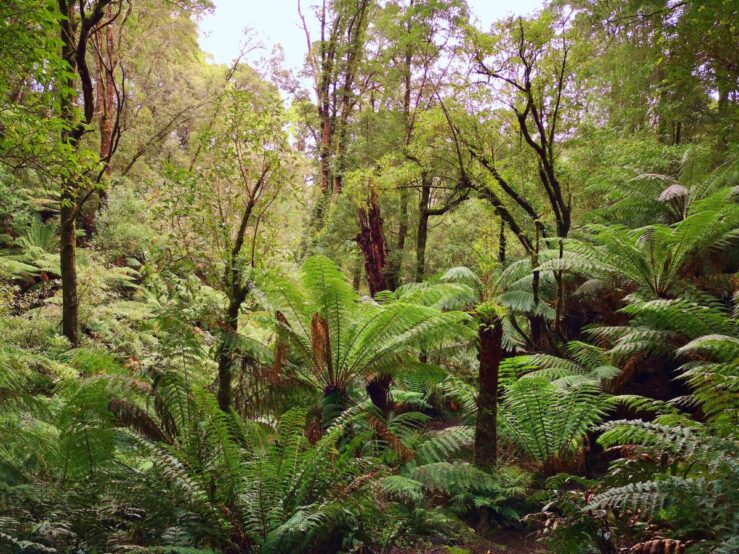
Otway Ranges temperate rainforest | Photo: Travel In Culture
Going much longer – over a million years – back in time, the Otway rainforest was within the Antarctic Circle, and the rainforest was home to now-extinct dinosaurs. Millions of years later, the indigenous Gadubanud people were the first humans who set foot on the Otway coastline. Their descendants are still today represented in the area.
Our Australian tour guide makes a real effort to teach us some Australian vocabulary – not only the conventional ‘G’day mate’, but also all the animal nicknames. Soon, we master the local colloquial terms for a koala, a kangaroo and an emu. A koala is a tree fluff, a kangaroo is a hopping chicken, and an emu is a speedy chicken!
Besides the Australian animals we get to view, the region is home to many other fascinating animals like wallabies, echidnas, platypuses, southern brown bandicoots, flying foxes, glow worms and a lot more…
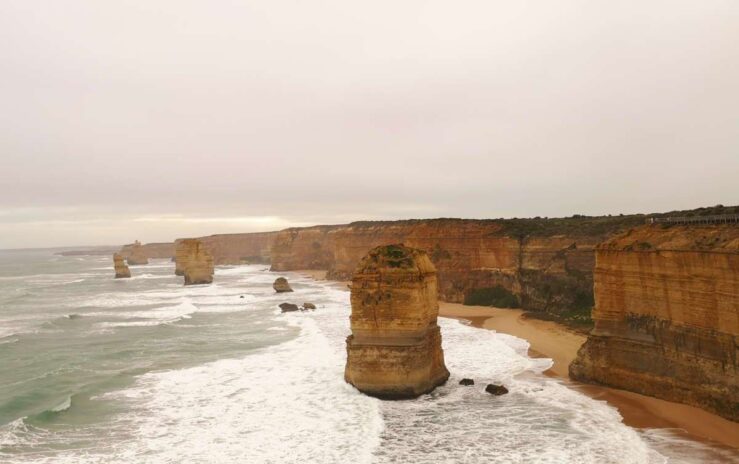
Today, only seven of the iconic Twelve Apostles remain | Photo: Travel In Culture
Finally, we arrive at the location of the Twelve Apostles, limestone stacks formed by erosion and carved out by the mighty ocean over millions of years. Standing up to 45 m (150 ft) tall off the coast, they are a most impressive sight. The early explorers of the 19th century named them ‘Sow and Piglets’ – which remained the unofficial name until the beginning of the 1900s. Another name previously used for the collection of stacks was ‘The Pinnacles’. The official name has, due to the awe-inspiring, monumental formations, biblical origin since it refers to the biblical 12 Apostles.
We follow the boardwalks to the lookout points to catch a glimpse of the marvels from different angles and with altering looks as the light changes. July is an ideal month to visit to get windswept shots of the iconic stacks.
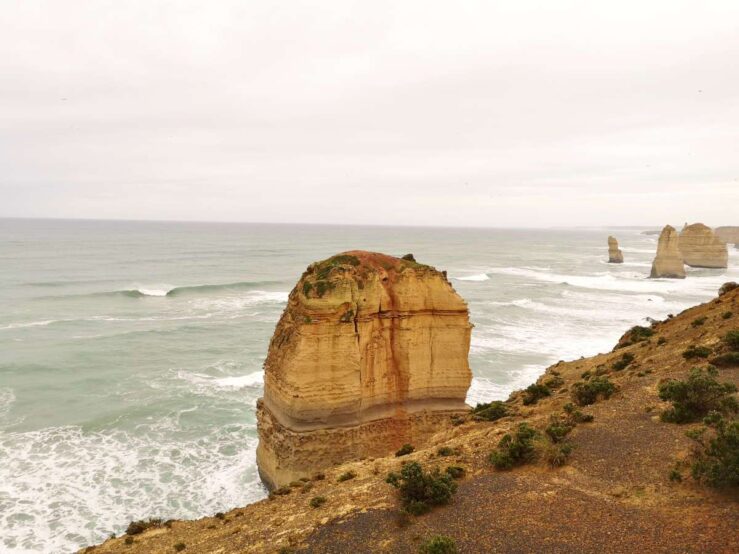
Each of the Twelve Apostles is an amazing limestone stack | Photo: Travel In Culture
There were never 12 of these soft rocks created and composed of layers of shells and other sea life, only 9. However, the 8th and the 9th collapsed in 2005 and 2009 – leaving just 7 limestone wonders on the site today. Nevertheless, more limestone stacks are on other sites along the coast towards Port Campbell. They are similarly exposed to erosion and slowly crumble into the ocean.
Besides the Australian animals, we get to view, the region is home to many other fascinating animals like wallabies, echidnas, platypuses, southern brown bandicoots, flying foxes, glow worms and a lot more…
We continue along the Shipwreck Coast – named after the uncountable number of incidents where ships were unforgivingly crashed towards the abruptly falling cliffs on the southern coast.
Many ships passed Cape Otway on the sea route between Europe and New South Wales in the 1800s. It was a dangerous coast, and many ships were wrecked here along the Port Campbell National Park – from where it got its name: the Shipwreck Coast. It is estimated that at least 700 ships were tragically wrecked here – and many of those were never found again.
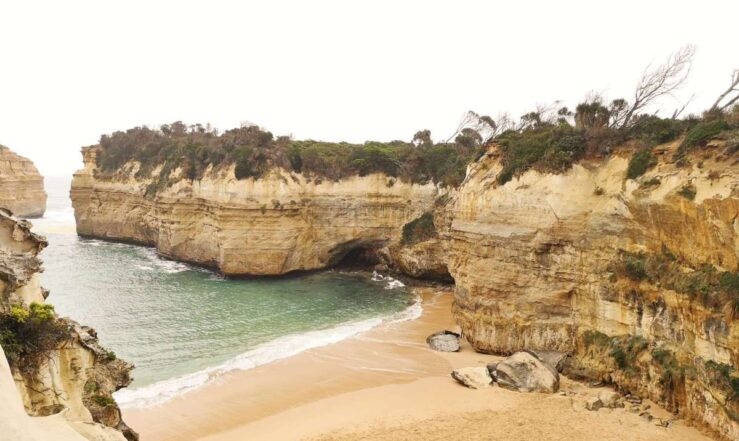
Limestone cliffs at Loch Ard Gorge | Photo: Travel In Culture
One of the famous lost ships was the clipper Loch Ard, which suffered a tragic fate in 1878 on its way from England to Melbourne under harsh weather conditions. Due to the fog, wind and current, the bow struck a reef and was brutally crushed by the smashing waves against the limestone cliffs. Subsequently, the site was named the Loch Ard Gorge after the ship. Only 2 of the 54 passengers and crew members survived the swelling sea, wiping everyone overboard. A young Irish woman, Eva Carmichael, and the cabin boy, Tom Pearce, were fortunate enough to be brought ashore by the current and the tide after hours of drifting around.
We walk along the cliffs at Loch Ard Gorge, and the incident suddenly feels authentic, as if it had just occurred. The views over the cliffs and the mighty ocean are breathtaking.
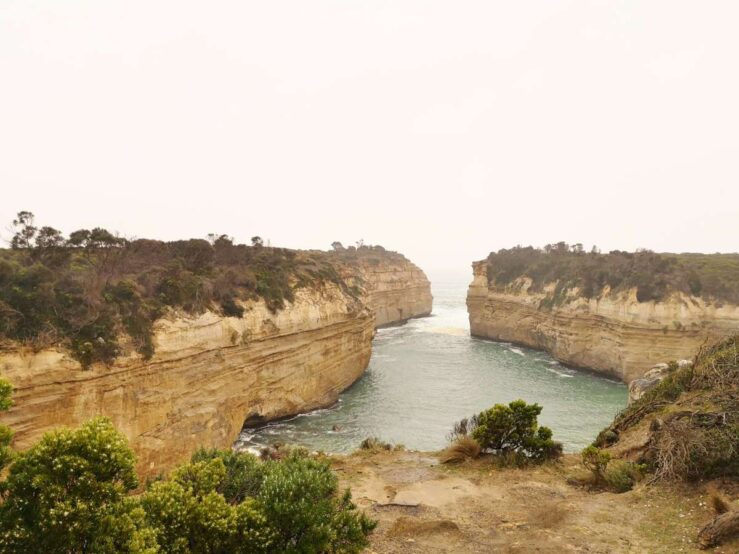
Loch Ard Gorge on the Shipwreck Coast | Photo: Travel In Culture
Simon has all during the day linked so many historical facts and geographical sites to his own family story and passionately conveyed it to our group. Therefore, we almost feel we are personally related to many of the locations we see along the road. The Great Ocean Road is an ingenious piece of work, built on untrodden cliffs by brave Australian men!
Read next: 10-Day Itinerary for Queensland and Explore Sydney in One day
Find useful travel gear: Travel Essentials
Travel Insurance / Visa
Have you considered what you will do in the (unlikely) event of something unforeseen happening? Do you need travel insurance? Check here if you need travel insurance for your trip – and check here if you need a visa for your trip and apply for it!
‘Exploring The Great Ocean Road Australia’
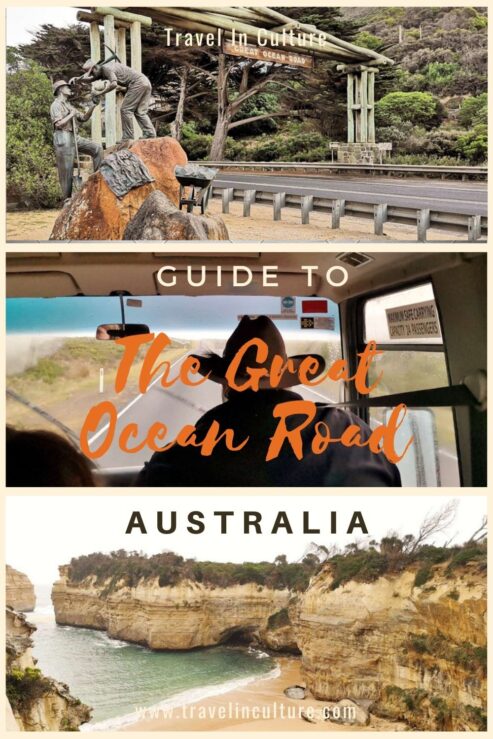
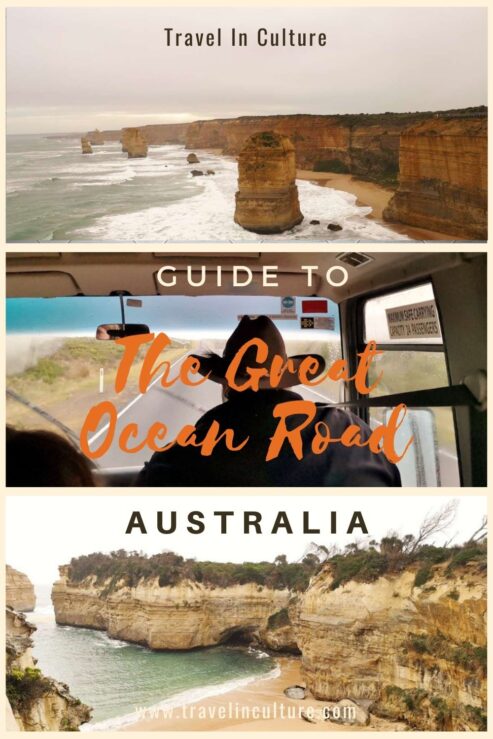
Featured image of
Exploring The Great Ocean Road Australia – G’day Mate:
Travel In Culture
The Great Ocean Road Australia




